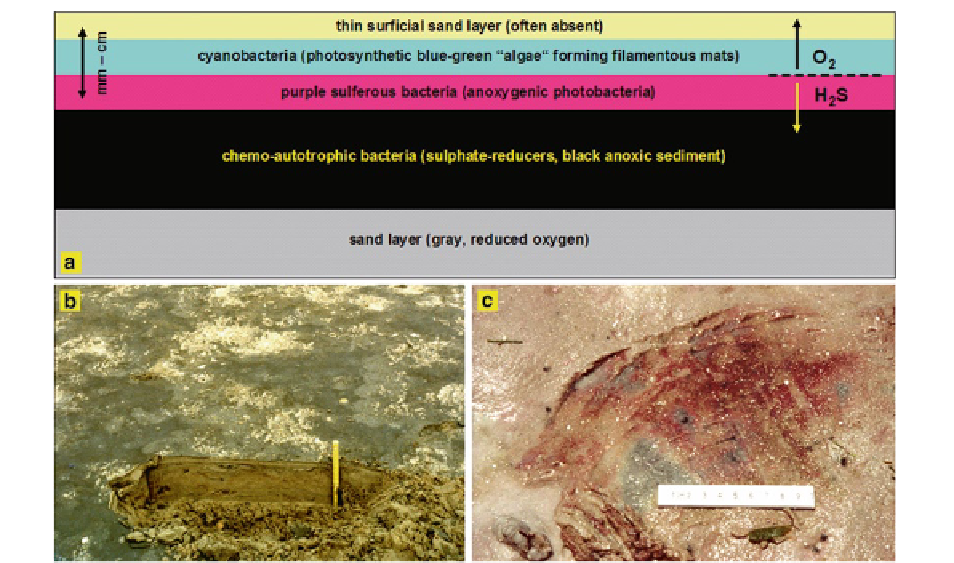Geology Reference
In-Depth Information
Fig. 10.23
Structure of a typical microbial mat occurring at the
land-sea transition around the mean high-tide level (upper inter-
tidal to lower supratidal). (
a
) Schematic model illustrating
the vertical succession of bacteria in a typical microbial mat;
(
b
) Photograph of a back-barrier microbial mat on the supratidal
flat of a Wadden Sea island; (
c
) Intensely purple colored sulfer-
ous bacteria beneath a thin layer of sand in the rear of a Gulf
Coast barrier island of Florida
carpet composed of oxygen-producing cyanobacteria
(blue-green algae) (Fig.
10.23b
). If covered by sand,
the cyanobacteria migrate to the surface where a new
mat is constructed, leaving behind the organic material
of the old mat below the sand layer. The organic matter
of the abandoned mat is then decomposed by so-called
chemo-autotrophic sulphate-reducing bacteria in the
course of which oxygen is depleted to produce a black
anoxic layer. Just beneath the cyanobacterial mat
anoxygenic sulferous photobacteria, identifiable by
their intense purple color, are frequently observed.
Being photobacteria, their activity increases markedly
from the darker high latitudes towards the brighter low
latitudes. Because of this, they are sometimes hard to
spot in places like the Wadden Sea (55°N), whereas
they occur in profusion in places like Florida (28°N)
(Fig.
10.23c
, cf. Davis
1994b
). Because sand covering
and subsequent upward migration of cyanobacteria
occurs relatively frequently, several black horizons
may be stacked above each other, the depletion of oxy-
gen also affecting the sand below the mats which takes
on a dark gray color. Due to the varied color scheme of
the mats, this laminated microbial facies straddling the
land-sea boundary has been given the apt name 'versi-
colored' tidal flat (Gerdes et al.
1985
). When pre-
served, the characteristic lamination associated with
specific bacteria makes it an excellent diagnostic tool
for the identification of the land-sea boundary in the
rock record (Schieber
2004
; Noffke et al.
2006
).
The trends of major parameters characterizing
intertidal flats along the energy gradient between the
mean low-tide and mean high-tide levels are summa-
rized in Fig.
10.24
. Parameters that decrease toward
mean high tide include hydrodynamic energy, duration
of water cover, submergence time, sand content of the
sediment, and physical sediment reworking. The oppo-
site trend is observed for mud content, exposure time,
organic matter content, phytobenthos (diatoms), and
plant fragments. Notable exceptions are seaweeds
which preferentially occur on mixed flats, microbial
mats that are restricted to a narrow zone around mean
high tide, and last but not least the mass concentration

